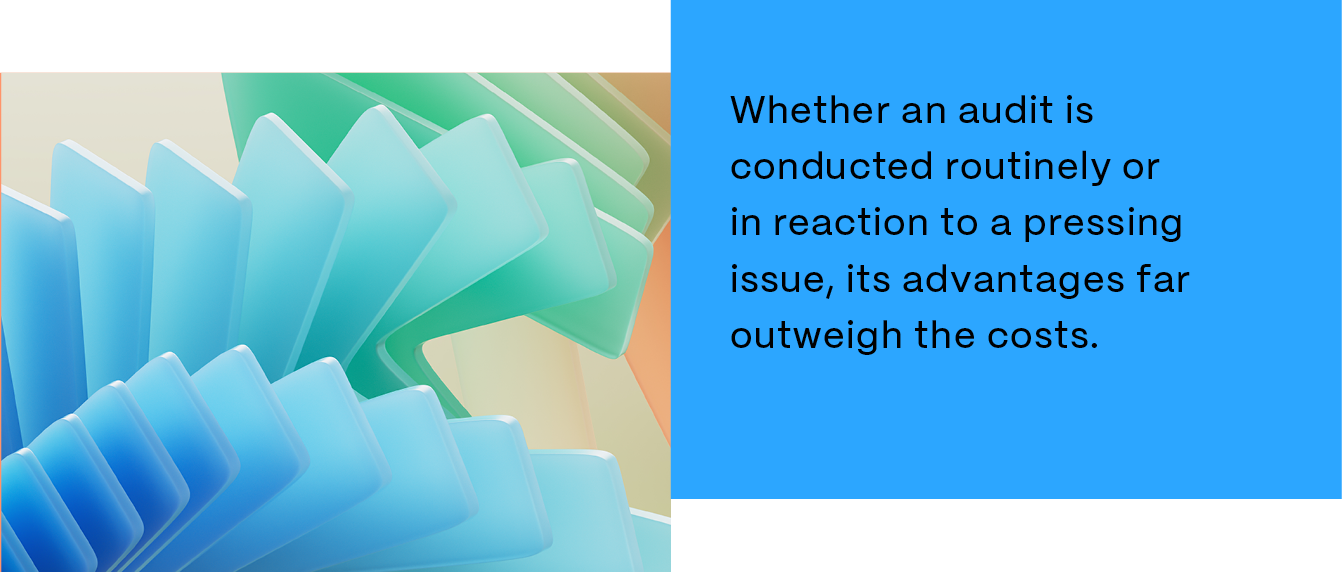
Blog
What is a software audit? types, benefits, and best practices

Think about the last time you looked into your current subscriptions: streaming services, digital media, regular deliveries, and anything else with automatic payments. Perhaps there were services you no longer needed, but still paid for. Maybe you realized it was time to update your information, or discovered a useful new feature.
Just as auditing personal subscriptions can yield surprising results that help you make better decisions, a software audit can uncover unexpected issues to address. It’s a crucial practice for those buying and using software as well as companies making and selling it.
In this guide, we explore what software auditing is, its types, benefits, steps, and best practices.
What is a software audit?
A software audit is an assessment that makes sure all software and systems are compliant, secure, and functioning properly. It’s a comprehensive process that can be done by an internal group of software experts or an external partner. Auditors consider factors such as software licenses, usage patterns, the number of installations, and any unauthorized or unlicensed use.
Keeping track of third-party integrations, licenses, and subscriptions can be tough. An audit helps guarantee these digital solutions meet industry and organizational standards. It’s also an opportunity for users to assess the value of software systems and for sellers to identify potential improvements.
Types of software audits
Regular software audits help uncover problems that lead to serious repercussions, such as security vulnerabilities and non-compliance. There are two types to be aware of.
External software audits
An external software audit is when you contract with an outside group to assess software. Hiring a third-party auditor with extensive software knowledge ensures a thorough and successful process.
External audits are often the best option for businesses that don’t have a team with in-depth auditing expertise or the time to set up a standard process. In some instances, an external audit is legally required by industry regulations.
Common examples of external audits include:
- Compliance audits: Checking to see if a company’s software meets the latest industry standards.
- Security audits: Enlisting a third party to look for any security issues.
- Usability audits: Testing how easy it is to navigate and use the software.
- Performance audits: Inspecting the efficiency of software systems.
Audits with legal ramifications should always be handled by an external party to eliminate the possibility of internal bias. However, undergoing an external audit before addressing risks internally may result in higher costs, legal issues, and negative publicity.
Internal software audits
An internal audit is conducted by a team within your organization. These should be done regularly to understand software capabilities, reveal concerns to address, and improve decision making.
Internal audits are not always legally compliant because of potential bias. However, they can be useful in uncovering software risks before an external audit occurs.
Examples of common internal software audits include:
- Software license audits: Verifying software compliance with licensing terms.
- Security audits: Assessing the strength of software security measures to protect sensitive customer, client, or company data.
- Functional audits: Evaluating the effectiveness of your company’s software to determine which solutions should be upgraded, adopted, or removed.
- Process audits: Establishing whether software supports the best possible workflows for company operations and what changes should be implemented if not.
Assessing compliance and capabilities internally gives insight into software improvements without the need to research and select an external partner. Internal audits are less costly and can generally occur more often to help maintain best practices and regulations.
On the other hand, internal audits require a skilled internal team with deep knowledge of company software. This team must establish or follow standard audit practices that the company can rely on to detect problems. When audits need to be done quickly but these elements are not in place, an external audit may be necessary.
Benefits of conducting a software audit
Whether an audit is conducted routinely or in reaction to a pressing issue, its advantages far outweigh the costs. Here are some benefits of internal and external software auditing:
Ensuring licensing compliance
Software audits uncover the use of unlicensed software and non-compliant licenses. This gives you time to correct issues before facing legal repercussions, penalty fees, and reputational damage.
Enhancing security
By identifying security concerns within software solutions, businesses can proactively avoid data breaches. Vulnerabilities can come from unexpected places, even minor apps that aren’t used often, so an audit provides peace of mind. It can also reveal opportunities to improve how you safeguard sensitive information.
Improving efficiency
An audit can analyze the efficacy of software applications, allowing companies to address gaps in efficiency. It provides insight into redundant applications as well as opportunities to streamline everyday processes. This lets companies make better decisions around which software tools to acquire, upgrade, or phase out to get work done faster.
Cost savings and optimization
Knowing which software applications are underused saves you money because it improves decisions about when to renew and terminate licenses. Audits that provide greater visibility into software licenses also give organizations greater ability to negotiate licensing deals with vendors.
Risk mitigation
Establish a regular cadence of software audits to proactively mitigate risks like poor security, non-compliance, and inefficiencies. Learning from past audits and applying those findings, plus scheduling audits in advance are the best ways to avoid future errors. This prepares teams to catch any new concerns that may have arisen.

How often should businesses conduct a software audit?
The right timing for a software audit depends on the specific nature of your software, security, and compliance needs. Generally, you should plan for it at least once a year.
Because audits catch compliance issues, skipping one can lead to legal consequences, fines, and security vulnerabilities. Gaps in security in particular increase the chance of a data breach that could cause massive losses.
There are also specific moments in time when an an audit is necessary, such as:
- Software solutions are running slow or not running as expected
- Software is suspected to be out of date
- Immediate security concerns arise
- A company is looking for ways to cut costs
Related read: Your guide to modern data security
How to conduct a software audit for your business
To carry out your own software audit, follow these five steps:
1. Define objectives and audit scope
Start by outlining the purpose of your audit and communicating goals to all staff affected by the process. To carry out the audit in a streamlined manner, employees must be aligned with the proceedings and comprehend their role. You should also determine which software to audit and approximately how long it will take. This allows you to organize your team and define objectives for an efficient and successful audit.
2. Create an inventory
Create an inventory of all the software tools and systems within your audit scope, so nothing is missed. Include licensed and unlicensed software, and gather all details about vendors, licenses, and version types.
3. Review licenses, documentation, and code
Once you have all material related to your software assets, begin the audit by evaluating software licenses, source code, and any related documentation. Thoroughly analyze these components and determine whether:
- Software is licensed: Make sure software is purchased from the correct vendor to avoid legal consequences, fines, and reputational damage.
- Software use is compliant with licenses: Always meet responsibilities outlined in a licensing agreement and don’t use outdated agreements. Non-compliance in these areas may result in security issues and penalties.
- Licenses are inactive or unwanted: Formally terminate unused software licenses with the vendor so you don’t end up with unnecessary fees.
- Related documentation is complete and accurate: Appropriately update vital references like user documentation, system documentation, and design documents.
- Source code is free of bugs: Check that code is free of technical problems, leaves no room for security vulnerabilities, and meets coding standards.
4. Assess security
Determine if your software meets rigorous security standards. Review the following to ensure it protects sensitive information:
- Software security features and settings. Assess whether these are adequate for industry regulations and make sure they’re enabled.
- Authentication measures. Verify that password policies are strong, sessions terminate after a set time, and multi-factor authentication is used to reduce the risk of unauthorized log-ins.
- Access controls and permissions. Evaluate whether software access controls are granting access to the right stakeholders at the right times. These should always be enabled for sensitive data.
Related read: A guide to protecting your data
5. Develop and present recommendations
After the audit is complete, compile a list of findings. Present insights in an actionable way so stakeholders understand what was uncovered and the necessary next steps. Depending on what you found, recommendations may include getting rid of unauthorized software, upgrading tools, or purchasing new solutions.
Software audit best practices
Wondering how to do a software audit and to get the most out of it? In addition to following the process described in this guide, keep the following best practices in mind:
Set an optimal audit schedule
Conducting audits regularly confirms that software and compliance issues won’t go unchecked, but performing them too often can be disruptive. Set an audit schedule that allows you to identify risks proactively, while avoiding excessive reviews that inhibit smooth operations.
Consider UX/UI
A standard software audit typically focuses on compliance, security, and technical capabilities, but user experience (UX) and user interface (UI) design should not be overlooked. For example, if an app is losing customers, it may be due to an interface that’s difficult to navigate rather than technical bugs. It may not be necessary to evaluate UX and UI every time, but if these factors are related to your audit scope they should always be included.
Review internal processes and workflows
Always consider company workflows during an audit. The way employees work can impact elements of software security, compliance, and effective use of technology.
Poor security habits like password sharing or failing to recognize phishing threats can lead to major gaps in data protection. In fact, 74% of data breaches include a human element, such as human error or the use of stolen credentials. Staff might also adopt practices that are less efficient if they aren’t using the software the right way.
Related read:How to quickly find weak points in your workflow
Get more out of your software with effective auditing
Running a software audit allows you to make sure digital tools and services are delivering value and remaining compliant. Whether internal or external, an audit can catch important issues and spur changes that improve customer trust and satisfaction. Annual audits can improve security, enhance compliance, and save money.
Leverage the best practices in this guide to conduct your own software audit and get out ahead of any challenges.

Related Resources

Blog